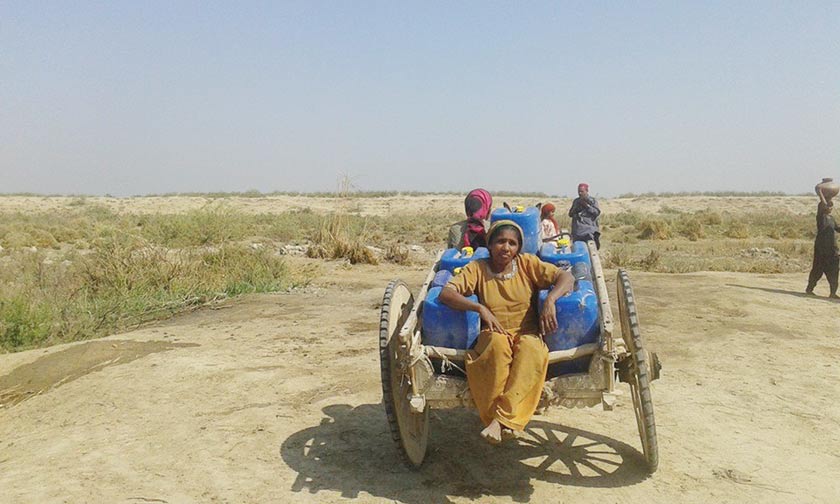Indigenous people and local fishermen in one of the poorest parts of the country in recent years have seen various mafia groups on political patronage scrambled to grab lands they have inhabited for generations.
Indigenous people and local fishermen in one of the poorest parts of the country in recent years have seen various mafia groups on political patronage scrambled to grab lands they have inhabited for generations.
Influential, natives called them ‘water mafia’, are on a rampage around Lake Manchar, Pakistan’s largest freshwater lake, to capture new territory and even to take over fish ponds -- the sole source of livelihood of the local communities.
 Analysts say a persistent migration of fisher folk from island villages and banks of Lake Manchar has created a vacuum, which is being filled by a mafia, whose members are on a rampage; taking over the water body, lands and vegetation on all sides, and leaving the indigenous people high and dry.
Analysts say a persistent migration of fisher folk from island villages and banks of Lake Manchar has created a vacuum, which is being filled by a mafia, whose members are on a rampage; taking over the water body, lands and vegetation on all sides, and leaving the indigenous people high and dry.
The community elders say that parts of the lake, which spreads over 233 square kilometres, dividing two districts of Dadu and Jamshoro, are being encroached from all the sides. They link the problem to the migration of more than 30,000 families in recent years that went to other waters in search of better living.
This migration created a gap, as nobody went to check on their lands and resources that were gradually being encroached. Politically influential people took over the vacant lands, vegetation and other resources, leaving no place to return to for the indigenous migrants who went away in search of greener pastures, and also creating hurdles for the ones who remained.
"It is unfair that our children are not being allowed to harvest nets near our own abodes," laments Qadir Bakhsh of Khan Muhammad Mallah Village.
It is the last village, located at the mouth of Main Nara Valley (MNV) drain flowing from Hamal Lake, Larkana district in to the Lake Manchar. The reports gathered by community activists reveal that the entire route of MNV drain, comprising 127km, is under control of different people at various points, depriving fishermen of their source of living.
This new move of establishing human settlements along the water body and on islands has disturbed the community people. There are two kinds of operators; some have taken control of the fish ponds inside the lake, while others have grabbed thick vegetating plants, where they bring influential people for killing and poaching the migratory birds. They never experienced such an uncomfortable situation.
Khan Muhammad Mallah comprises 450 households scattered on both sides of the MNV stream.
Bakhsh, now over 70-year-old, claims he was born and raised in this village. “This place where we live now was once just a neglected area that served as a route to stop over for the countless gypsy families that roam the plains of Sindh. They used to cross waters, plain lands and mountain ranges the whole year, wandering towards their unknown destinations. They stayed here along the water banks, hunted animals, and left as calmly as they came,” Qadir narrates.
Countless species of mammals and reptiles found a safe haven near the thick vegetation around the water body. He claims his community was the custodians of this wonderland of water, trees and shrubs for decades. This was also their source of income until some time ago, he said. “But now it is the property of certain influential people,” he said regretfully.
Qadir sorrowfully relates the dispossession of the indigenous population of the Manchar by those with political connections. “These outsiders now claim ownership of this land, violating our natural right. Our children are not allowed to harvest nets anymore,” he said.
Activists however said the fish stocks started dwindling back in 1974 when the government decided to turn the lake into a reservoir with a level of at least 12 feet. Since then, a large number of fisher folk migrated to other marine areas and inland waters for better livelihood.
The government had built an embankment on two sides; leaving the other two sides open to receive streams of rain water from the hilly areas during monsoons. These rain-fed streams flowing from the Kirthar Mountain ranges into the lake helped replenish the water of the lake for decades.
However, community elders claim that the lake, which was once filled with fish, water vegetables and valuable plants, became known as a saline wetland until the floods in 2010, 2011, 2012, and again in 2015. As the floodwaters brought with them more fresh water and fish seed, restoring vegetation zones, they heaved a sigh of relief. More vegetation and weeds meant safer breeding grounds for fish species.
In 2015, after monsoon, local fishermen even saw a number of new fish species, some of them weighing around three kilograms. This was a sign of prosperity for them.
But to reap the bounty, the locals need to get access to the water and regain ownership of their land.
Mustafa Meerani, a local community leader, said there are around 250 villages with around 0.4 million population near the lake. “The exact figures and population can only be found after the census, but the migrations did create a wide gap, which left room for encroachment,” he said.
Mustafa said all sides were encroached. “Fishermen depend solely on the lake for their livelihood, and since they are being barred from using the lake, they are facing hardships. There is no contract system, and it is a challenging situation for the community,” he said, adding the government officials were reluctant to pay heed towards the matter.
Since the encroachers have a hold on the areas around the lake and also on the islands within, the local populace cannot move around in their boats. Boats are the main form of transport between islands and for collecting water plants to manufacture various handicrafts.
Water pollution, contamination
For the locals, there seems to be no end to their hardships at the lake. Apart from being gradually dispossessed of their native land and lake, they also have to face the rising pollutants in the water reservoir, which have also poisoned the aquifers.
The MNV, a part of the controversial Right Bank Outfall Drain (RBOD), carries effluent through the upper parts of the country, discharging it in the fresh water lake.
The RBOD was planned 40 years ago to carry effluent to the sea, crossing through the fresh water lake and then flowing by the River Indus bank. The planners earlier might have assumed that frequent rains could wash away the waste, but the current changes in the weather due to climate change have complicated the matter.
Ayaz Ali Meerani, community activist of Mayani Areesar, says the entire area close to the lake does not have safe drinking water. “The 2010 flood had washed away the entire water facilities installed at different locations. So the non-governmental organisations had installed hundreds of hand pumps without checking the underground water quality in villages,” he disclosed.
There might be some scattered hand pumps remaining which have access to potable water, and people take their bikes, donkey carts, and other vehicles to fetch water for their domestic needs.
He accredited the decision of the Supreme Court of Pakistan, which took notice of the poisoned drinking water, and the government installed 12 reverse osmosis (RO) plants around the lake in 2013. “Out of those, only five RO plants are reportedly functional now due to various reasons from faulty electricity mechanism to carelessness of operators,” Ayaz shared.
Boat-school sailed away
There was a private boat-school in village Khan Muhammad Mallah, run by two teachers, where children used to come for learning. It was a ray of hope for the community children, but after a few years it was closed. During the school days, it was an inspiring place with a large number of educationists taking an interest. Now, it has been destroyed and there is mounting fear and uncertainty among the community people.
Amid the depleted resources, there is still one boat village on Lake Manchar, village Umar Mallah. Comprising 17 residential boats that float along the waters, it is the symbol of the past glory and what is left of the indigenous life of those who called Manchar their ancestral home.
The boats of village Umar Mallah come together at sunset to form their village, and scatter during the early hours of the morning to catch their share of fish for the day. They await the government to take action against those who are destroying their ancestral wetlands. A few days ago, on February 2, on World Wetland Day, environmentalists once again reminded about the ignored Lake Manchar and its heritage which is being destroyed by those motivated by greed.
Politically influential people are not only establishing settlements of non-locals along the MNV and in and around the lake, but also ruining the wetland ecology, the environmentalists said.
The writer is a staff member